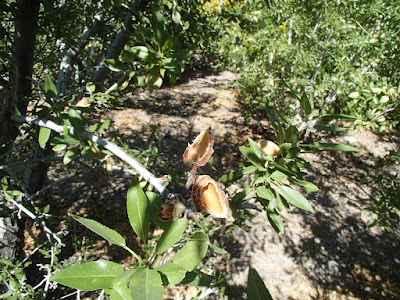I have had many complaints about using plants like Japanese blueberry, Carolina cherry laurel, or Bay Laurel for a privacy hedge. I decided to create my own list. Hedges for privacy are usually evergreen or will hold their leaves as long as possible through the winter. You may have to order them online if not available locally.
 |
| Carolina cherry laurel with water stress. |
Good to 25F or Less and Full Sun
These evergreen or mostly evergreen plants can be planted in full sun and away from other plants. These plants will survive winter cold temperatures to at least 20F and high temperatures over 120F. They will need it if they are surrounded by rock, exposed, and in full sun.
How Tall?
Judge how tall you need your privacy hedge. Use smaller plants when possible. Larger plants need more water as they get larger. If planted in a row, use drip tubing. Spacing for a hedge should be 1/3 of their mature height. Most can be sheared with a hedge shears to increase their privacy factor. Mesic plants can use more water than xeric plants but it depends how you water them.
Mesic vs. Xeric
Xeric or desert plants can handle less frequent watering. Mesic or nondesert plants should be watered with other landscape trees and shrubs. Xeric plants should be watered with other xeric plants. Use drip tubing or bubbler/basins rather than individual drip emitters.
How to Plant?
Plant in the fall or spring. Plant them as you would other landscape plants; with compost and a pre-plant fertilizer. Surround them with rock mulch or woodchips. Your choice. Fertilize them once in the early spring each year. Stake them only for one year after planting.
How to Prune?
Pruning may be necessary once every five to ten years. Prune them to the ground and let them regrow from their roots.
Under ten feet
5 to 8 feet Cape Honeysuckle. Can freeze in winters. Evergreen and showy.
3 to 10 feet Jojoba. Water controls growth. Xeric. Evergreen. Tough.
8 to 10 feet 'Green Cloud' or 'Silver Cloud' Texas Ranger. Not evergreen but they are dense enough to provide some privacy in the winter. Make sure it is the correct variety and not a dwarf type. Xeric. Will grow back slowly. Tough.
Over ten feet
10 to 15 feet Red or white flowered standard Oleander. Evergreen and can handle low winter temperatures and stay green. Mesic. Tough.
10 to 15 feet Little leaf Cordia. Hard to find but evergreen but can be deciduous when it freezes hard. Xeric. Tough.
10 to 15 feet Texas Mahogany. Purple flowers in the spring. Evergreen. Genista moth in the spring can chew leaves. Xeric. Tough.
10 to 15 feet Hopseed Bush. Requires well drained soil. Xeric. Tough.
8 to15 feet Cassia aka Senna. Many different kinds. Mesic. Tough.
Over 15 feet
15 to 20 feet Lady Banks Rose. Can get large. During winter freeze it can become deciduous. Mesic.
Over 20 feet
25 - 30 feet 'Swan Hill' or 'Wilsonii' European Olive. Evergreen and must be pruned to a bush form for privacy. Mesic. Some fruit produced when it is older. Tough.






















